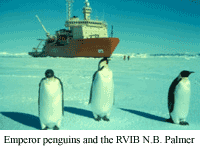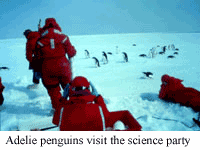Polar environments are ecosystems characterized by extreme low temperature and seasonal extremes of photoperiod. Low temperature presents unique challenges to living microorganisms due to its effect on metabolic rates, and thus on the processes of feeding, digestion and reproduction. Nevertheless, protistan species abound in the water column and sea ice of the Arctic and Antarctic marine ecosystems. The Ross Sea is a highly productive coastal ecosystem within the Southern Ocean, the great oceanic region surrounding the continent of Antarctica. Within this coastal sea, the Ross Sea polynya is an area that experiences open water seasonally (a polynya), that is still surrounded by ice on the continental and seaward sides. Surface water temperatures during austral summer in the polynya are generally <1.0°C, yet this area is characterized by a dense and spatially extensive phytoplankton bloom that develops rapidly through austral spring and summer.
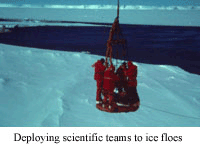
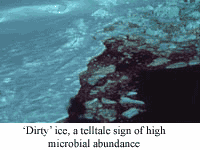
Our initial research in the Ross Sea some years ago entailed genetic studies of the species diversity and metabolic activity of protists (microalgae and protozoa) in the Ross Sea polynya and ice ecosystems, in an effort to understand the structure of microbial communities at extremely low temperature, and the ability of these species to grow and reproduce under these conditions. This project was initiated as one component of the Life in Extreme Environments program of the National Science Foundation (NSF), and continued as a project funded by the Office of Polar Programs of the NSF. Physiological studies were made possible by the establishment of a large culture collection of Antarctic protists. A fundamental finding of the project was that low environmental temperature appears to constrain the maximal growth rates of microbial consumers more than the growth rates of microalgae (See Figure). This situation may limit the activities of zooplankton during austral spring and may, in part, explain why the Ross Sea experiences massive accumulations of microalgae. For more information see Rose and Caron, 2007.
Our latest research in the Ross Sea examined how herbivorous zooplankton obtain their nutrition in this perennially cold environment. This ecosystem is unique in that it is dominated in different regions of the sea by different algae, some of which are considered prey of high food quality for zooplankton, while others are considered unpalatable. The south-central Ross Sea polynya is dominated by the prymnesiophyte Phaeocystis antarctica (a species considered unpalatable by most zooplankton), while Terra Nova Bay, a small embayment within the Ross Sea, is dominated by diatoms (generally considered high quality food). Our research project focused on comparing the nutrition of the dominant zooplankton (minute crustacea) in these two locales.
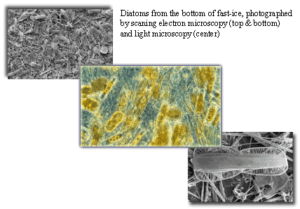 Our basic hypothesis was that much of the photosynthetic material in the south-central Ross Sea polynya is produced by the prymnesiophyte Phaeocystis antarctica that is not consumed directly, but is eaten by herbivorous protists, or decomposed by bacteria which are then eaten by bacteria-eating protists. Therefore, predatory protists might be the dominant food source for crustacean zooplankton in this situation. In contrast, we hypothesize that much of photosynthetic material that is produced in Terra Nova Bay was diectly consumed by crustacean zooplankton because the algal species there are more palatable.
Our basic hypothesis was that much of the photosynthetic material in the south-central Ross Sea polynya is produced by the prymnesiophyte Phaeocystis antarctica that is not consumed directly, but is eaten by herbivorous protists, or decomposed by bacteria which are then eaten by bacteria-eating protists. Therefore, predatory protists might be the dominant food source for crustacean zooplankton in this situation. In contrast, we hypothesize that much of photosynthetic material that is produced in Terra Nova Bay was diectly consumed by crustacean zooplankton because the algal species there are more palatable.

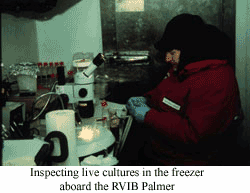 Our study employed experimental manipulations, genetic approaches and microscopy to investigate the importance of the detritus-bacteria-protozoan food web connection. A major field effort for this project was conducted during January and February 2008 aboard the Research Vessel Nathaniel B. Palmer. The experimental studies employed the exclusion or addition of crustacean zooplankton to determine on the effects of manipulating zooplankton abundances on the protistan community. Genetic and microscopical techniques were used to follow changes in the protistan community during these experiments, and the information used to determine which species were being consumed by the zooplankton.
Our study employed experimental manipulations, genetic approaches and microscopy to investigate the importance of the detritus-bacteria-protozoan food web connection. A major field effort for this project was conducted during January and February 2008 aboard the Research Vessel Nathaniel B. Palmer. The experimental studies employed the exclusion or addition of crustacean zooplankton to determine on the effects of manipulating zooplankton abundances on the protistan community. Genetic and microscopical techniques were used to follow changes in the protistan community during these experiments, and the information used to determine which species were being consumed by the zooplankton.
Below is a diagram indicating the major trophic interactions between protistan populations (microscopic algae and protozoa) and zooplankton in the Terra Nova Bay (TNB) area and the south-central Ross Sea Polynya (RSP) during austral summer/fall. The arrows indicate the flow of energy in predator-prey interactions, and the thickness of the arrows indicates the relative contribution of each prey to the diet of its consumer.
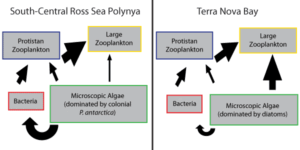
Outreach and education for this project included a number of efforts. Several undergraduate and high school students were hosted in our lab and those of our collaborators, and we participated in a NSF-funded program (Centers for Ocean Science Education Excellence; COSEE-West) that used ocean themes to improve math and science education in K-12 schools in Southern California. During our January 2008 cruise we constructed and ran an interactive website from the ship that had daily interactions with seven elementary and middle schools across the U.S..
Our present collaborators on this program are Dr. Darcy J. Lonsdale and Robert Cerrato of Stony Brook University in New York, and Dr. Astrid Schnetzer of North Carolina State University and Karla Heidelberg of USC. Dr. Rebecca J. Gast of the Woods Hole Oceanographic Institution collaborated with our lab on past projects in the Ross Sea (diversity and culture studies of protists).
